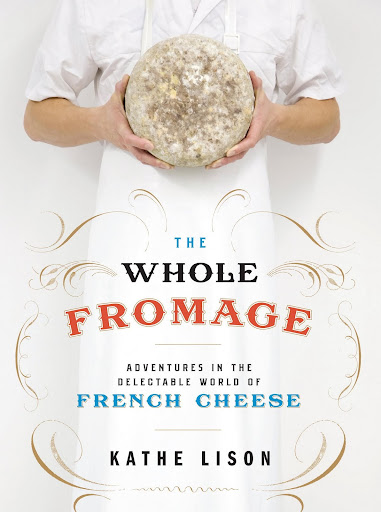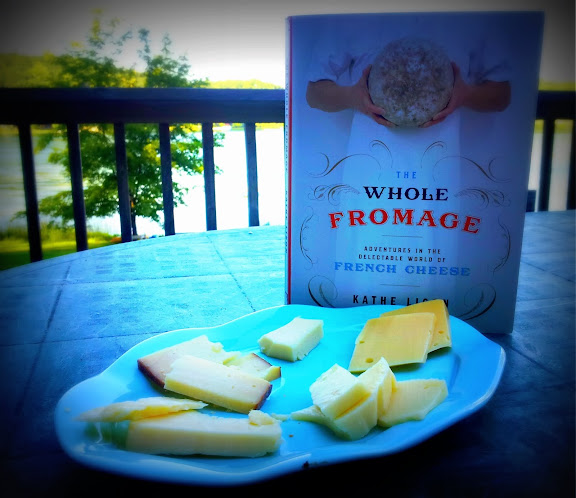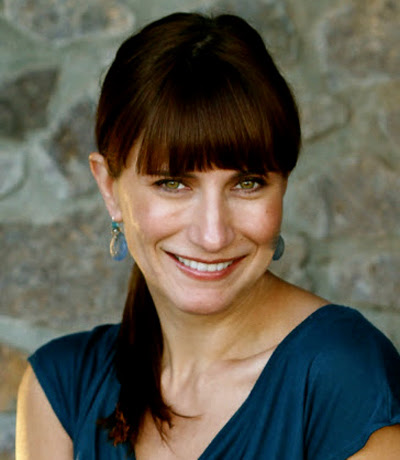As anyone (anyone!) who has been to France knows quite well, fromage in France is, well…there’s nothing like it. Fromage (cheese) is almost a religion there – and rightly so. It’s delicious, otherworldly, and utterly unique wherever you go across France. And, it’s one (the main one, for me) of many reasons people travel to France – the food, the cheese, the culinary goodness.

If this is you, then I have the book for you! The Whole Fromage: Adventures in the Delectable World of French Cheese, by Kathe Lison, is at once an adventure and a guide. Here’s the deal – she delves, quite deeply, into the mysteries of French cheesemaking – the geography, people, cows, terroir, traditions, regulations, appellations, differences, history – so well that you’ll read this book in one sitting (as I did), punctuated by a few trips to replenish the fromage plate. It’s that good.

Reading the Whole Fromage in one gulp - with a cheese plate, of course
Lison takes her curiosity about French cheese and follows her nose – all over France. It’s lovely, her stories of hiking up rural mountains, discussing cows, smelling the flowers in the air (and in the cheese), turning cheeses, discussing modernity and what is lost to progress, and even becoming a Membre d’Honneur de la Confrérie des Taste-Fromages de Langres. She ranges over the whole of France, and makes each specific cheese stand out to us. I tell you, I know more about fromage now than I ever thought I would. And, if you’re like me, you’ll be planning trips to France around this book – a whole new sort of itinéraire des fromages. Take a look, for instance, at Roquefort:
A single spore of Penicillium roqueforti may be invisible to the naked eye; even so, the microscopic beasties are wholly responsible for the clutter of buildings lining the narrow streets of Roquefort-sur-Soulzon; the entire village springs from mold. Above the office buildings and restaurants and houses, the Combalou – from the Gaulish combal, for “saddle” – stretches for over a mile and a half, and all Roquefort in the world comes from this one craggy escarpment of rock.
See? I highly recommend this book to anyone that loves cheese, and France – it’s an academic love story, an ode to the long history of artisans and craftsmanship, a discussion of the hard work involved in turning milk into ambrosia, a mouthwatering exploration of the extraordinary tastes of fromage. It’s one of the best books I’ve ever read. And upon reading it, you, too, will be mapping out your next few journeys to France.
We were lucky enough to catch up with author Kathe Lison, and ask her about the book, inspiration, research (!), challenges, and more. Here’s what she had to say…

Kathe Lison - photo by Echo Chanel
Please tell us about your book, The Whole Fromage...
The Whole Fromage is a combination of travelogue and food history, told from a personal point of view. It’s true that many guidebooks to French cheese exist, and I certainly consulted many of them while doing my research, but I wanted to create a book about French cheese that would offer a more intimate portrait than is typically found in a guidebook. What I was trying to create was the sort of book I wished had existed when I first began to want to know more about French cheese: entertaining to read, while also still informative. I used to teach English, so I suppose you could say that the teacher in me came out.
What inspired you to write this book?
I’m originally from Wisconsin, and I’d always been a huge fan of cheese. I studied French in Paris as an undergraduate, but somehow managed to miss almost all of the fromage! Years later I went back and, having purchased a few cheeses from a shop to take home, bought a guidebook to learn more. The book was largely pictures—fabulous and near-fantasical pictures of cheeses. I was dazzled by the array, and knew that I had to know—and eat—more.
How many years did you do research for the book?
I spent the better part of a year in and out of France, doing research. I also did sort of a summer pre-trip, and then another summer post-trip, during which I did some follow-up work. The research proved to be a lot more involved than I’d anticipated; just planning each new journey meant weeks of pouring over maps of France, attempting to pinpoint tiny hamlets and farms. But the travel that resulted from that was fantastic. If you really want to get to know France, I have three words of advice: follow the fromage.
Wedge of Salers. Photo: Kathe Lison
What was the most challenging aspect of researching this book?
Though I’m quite fluent now, I found my college-French was fairly rusty when I first began, so that was definitely a challenge. It was also difficult being gone from home for long stretches of time. But there was also the sheer size of the subject: there’s an awful lot of information out there about French cheese, and an awful lot of people to talk to. The initial manuscript I turned in was huge—three times the length of the finished book. Just hewing that (I’ve come to think of it as the “kitchen sink” draft) down to something reasonable took considerable time and effort, not to mention a lot of support from a really great editor.
What might readers be surprised to find, about French cheese?
I think they might be surprised by how down to earth many French people are, especially when it comes to cheese. We tend to stereotype the French as rather cold and snooty, but most of the people I met on my travels were incredibly welcoming and not the least bit pretentious. The French are genuinely proud of their cheese heritage and eager to share it with interested outsiders.
You wrote about traditional ways of making cheese, and more modern ways, and combinations of the two. What do you think is the path that most cheesemakers will take? How can French cheesemakers work to preserve the taste?
We tend to think of traditional and modern cheesemaking as being antithetical; even so, I would argue that much of what gets thought of as “modern” is really just evolution. Cheese technology is and has always been evolving. Granted, it now evolves at a much accelerated rate, and it is possible to lose the essence of what makes a cheese great if producers aren’t careful. That, I would say is the path most cheesemakers are on: one on which they have to and want to and likely already have implemented new methods, but still must be careful about how they do so. The trick is to find technology that essentially replicates the sorts of monotonous tasks that it’s become hard to find humans to perform, while not compromising the finished cheese. A great example of a good solution is the robots which turn and flip thousands of rounds of huge gruyère style cheeses in the French Alps and Jura region. The robots may not be traditional, but they’re still doing a very traditional task, and the finished cheeses aren’t affected in the least for having gotten a little high tech help.
What's up next for you?
At the moment I’m taking a bit of break from writing to study another of my passions: architecture. We’ll see where that takes me!
Learn more at:
https://www.facebook.com/TheWholeFromage
Note: We received a review copy of this book from the publisher. Thank you so much!
Ah, fromage... an interview with author Kathe Lison, about her book The Whole Fromage: Adventures in the Delectable World of French Cheese
Posted by: Jessica Voigts
